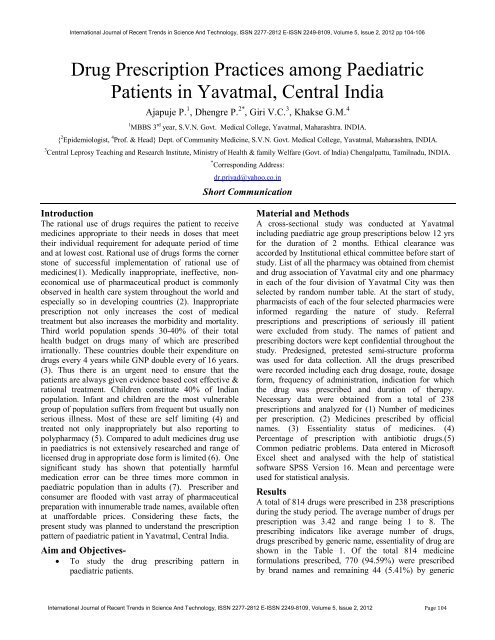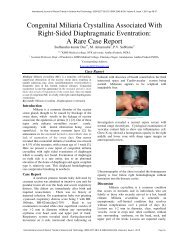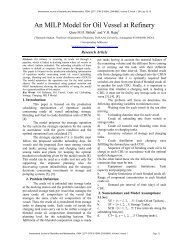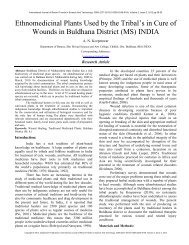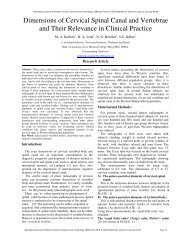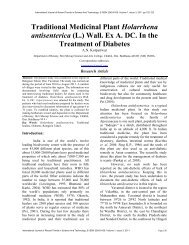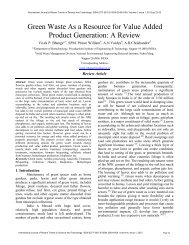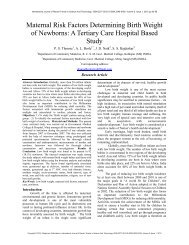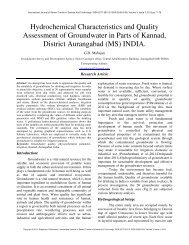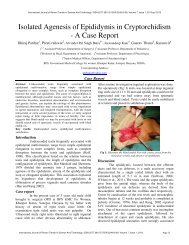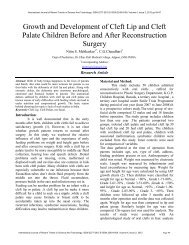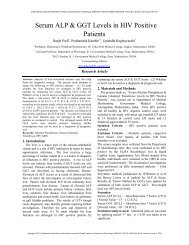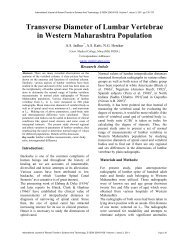Drug Prescription Practices among Paediatric Patients ... - Statperson
Drug Prescription Practices among Paediatric Patients ... - Statperson
Drug Prescription Practices among Paediatric Patients ... - Statperson
You also want an ePaper? Increase the reach of your titles
YUMPU automatically turns print PDFs into web optimized ePapers that Google loves.
International Journal of Recent Trends in Science And Technology, ISSN 2277-2812 E-ISSN 2249-8109, Volume 5, Issue 2, 2012 pp 104-106<strong>Drug</strong> <strong>Prescription</strong> <strong>Practices</strong> <strong>among</strong> <strong>Paediatric</strong><strong>Patients</strong> in Yavatmal, Central IndiaAjapuje P. 1 , Dhengre P. 2* , Giri V.C. 3 , Khakse G.M. 41 MBBS 3 rd year, S.V.N. Govt. Medical College, Yavatmal, Maharashtra. INDIA.{ 2 Epidemiologist, 4 Prof. & Head} Dept. of Community Medicine, S.V.N. Govt. Medical College, Yavatmal, Maharashtra, INDIA.3 Central Leprosy Teaching and Research Institute, Ministry of Health & family Welfare (Govt. of India) Chengalpattu, Tamilnadu, INDIA.* Corresponding Address:dr.priyad@yahoo.co.inShort CommunicationIntroductionThe rational use of drugs requires the patient to receivemedicines appropriate to their needs in doses that meettheir individual requirement for adequate period of timeand at lowest cost. Rational use of drugs forms the cornerstone of successful implementation of rational use ofmedicines(1). Medically inappropriate, ineffective, noneconomicaluse of pharmaceutical product is commonlyobserved in health care system throughout the world andespecially so in developing countries (2). Inappropriateprescription not only increases the cost of medicaltreatment but also increases the morbidity and mortality.Third world population spends 30-40% of their totalhealth budget on drugs many of which are prescribedirrationally. These countries double their expenditure ondrugs every 4 years while GNP double every of 16 years.(3). Thus there is an urgent need to ensure that thepatients are always given evidence based cost effective &rational treatment. Children constitute 40% of Indianpopulation. Infant and children are the most vulnerablegroup of population suffers from frequent but usually nonserious illness. Most of these are self limiting (4) andtreated not only inappropriately but also reporting topolypharmacy (5). Compared to adult medicines drug usein paediatrics is not extensively researched and range oflicensed drug in appropriate dose form is limited (6). Onesignificant study has shown that potentially harmfulmedication error can be three times more common inpaediatric population than in adults (7). Prescriber andconsumer are flooded with vast array of pharmaceuticalpreparation with innumerable trade names, available oftenat unaffordable prices. Considering these facts, thepresent study was planned to understand the prescriptionpattern of paediatric patient in Yavatmal, Central India.Aim and Objectives- To study the drug prescribing pattern inpaediatric patients.Material and MethodsA cross-sectional study was conducted at Yavatmalincluding paediatric age group prescriptions below 12 yrsfor the duration of 2 months. Ethical clearance wasaccorded by Institutional ethical committee before start ofstudy. List of all the pharmacy was obtained from chemistand drug association of Yavatmal city and one pharmacyin each of the four division of Yavatmal City was thenselected by random number table. At the start of study,pharmacists of each of the four selected pharmacies wereinformed regarding the nature of study. Referralprescriptions and prescriptions of seriously ill patientwere excluded from study. The names of patient andprescribing doctors were kept confidential throughout thestudy. Predesigned, pretested semi-structure proformawas used for data collection. All the drugs prescribedwere recorded including each drug dosage, route, dosageform, frequency of administration, indication for whichthe drug was prescribed and duration of therapy.Necessary data were obtained from a total of 238prescriptions and analyzed for (1) Number of medicinesper prescription. (2) Medicines prescribed by officialnames. (3) Essentiality status of medicines. (4)Percentage of prescription with antibiotic drugs.(5)Common pediatric problems. Data entered in MicrosoftExcel sheet and analysed with the help of statisticalsoftware SPSS Version 16. Mean and percentage wereused for statistical analysis.ResultsA total of 814 drugs were prescribed in 238 prescriptionsduring the study period. The average number of drugs perprescription was 3.42 and range being 1 to 8. Theprescribing indicators like average number of drugs,drugs prescribed by generic name, essentiality of drug areshown in the Table 1. Of the total 814 medicineformulations prescribed, 770 (94.59%) were prescribedby brand names and remaining 44 (5.41%) by genericInternational Journal of Recent Trends in Science And Technology, ISSN 2277-2812 E-ISSN 2249-8109, Volume 5, Issue 2, 2012 Page 104
Ajapuje P., Dhengre P., Giri V.C., Khakse G.M.name. A total of 665(81.69%) drugs were included in themodel list of essential medicine whereas the remaining149(18.31%) drugs could be constructed as non-essential.186 (78.15%) children were prescribed one or moreantibiotics during the study period. Table 2 shows themost commonly prescribed classes of drugs. Antibioticswere most commonly prescribed 203 (24.93%), followedby antipyretic and anti-inflammatory drugs 158 (19.41%).Multivitamins constitute 122(14.98%) of drugs. The mostcommonly used individual drugs are shown in Table 3.Cefpodoxime (29.06%) and Paracetamol (86.70%) weremost commonly used drugs from each of the class. It wasalso noted that out of 238 prescriptions studied, 124(51.26%) had at least one multivitamin, iron or tonicprescribed. The rationale behind adding of suchmultivitamin or other tonic was not justified. In paediatricpractice, dose of the drug is calculated taking intoconsideration the age & weight of the patient, but in ourstudy we found that weight of the patient was notmentioned in 68.90%. The top two clinical conditions forwhich drugs were prescribed included fever, cough andcold 162 (60.07%) followed by gastrointestinal tractinfection 51( 21.42%). In total of 162 prescriptionspresenting with fever, cough & cold, we found that 74(45.67%) children were prescribed with antibiotics. Outof total 238 prescriptions, prescriptions prescribed byMBBS doctors, MD(pediatric), DCH were 34(14.28%),194(81.51%), 10(4.20%) respectively.DiscussionIn the present study, on an average 3.42 medicines wereprescribed per patient as compared to 2.3 and 2.22 fromSpain (8) and Karnataka(9) respectively. Prakash etal,(11), Ansari et al,(3) and Nazima et al(12) found thisnumber to be 5.86, 5.05 and 3.72 medicines perprescription respectively in their studies. We also foundthat more than half of patients were given three or moremedicines. Thus it is evident that the polypharmacy andover prescribing are common in India. Various reasonscan account for this situations like ambiguity in diagnosisin a patient presenting with multiple symptoms, demandfor quick relief from patient; availability of non-essentialand irrational drug combination and aggressive medicineTable 1: Prescribing patternIndicatorResultAverage no of drugs per encounter 3.42%<strong>Drug</strong>s prescribed by generic name 5.41%Essential drugs 81.69%Anti microbials prescribed 78.15%promotion (3). Correct diagnosis of a disease and itsmanagement with medicines, constitute an importantaspect of patient care which is even more important incase of paediatric patients. For this, it is very prudent tostudy the prescribing practice in paediatric patient inorder to find out lacunae, if any and suggest remedialmeasures to overcome the same. The findings of ourstudy highlight the continuing crisis of irrational drugprescribing in the country. Given that the vast majority ofdrug purchase costs are borne out of pocket, the ultimateburden of this irrational drug use falls entirely on thepatient. More medicines increase the risk of druginteractions, adversely affect the patient compliance andhike the cost of treatment. In this study, 5.41% of themedicines were prescribed by their generic names.Mohanty BK in Rajamundry found that 30.70%medicines were prescribed by generic names. WhileJanaki R in Karnataka reported that 96% medicines wereprescribed by generic name. Prescribing medicines bygeneric name avoid the confusion and makes therapyrational and cheaper. Moreover in the teachinginstitutions world over, in textbooks, in scientific journalsand in the research publications, medicines are alwaysmentioned by generic names. Despite this, most doctorsprescribe the medicines by their brand names. The reasonfor this could be (1) tradition (2) aggressive medicinepromotion (3) availability of multi-ingredient fixed dosedrug combination. In this study, 81.69% of the medicinescould be rated as essential. Naziya Y. Mirza et al found77.61% medicines prescribed were essential. Whereas57.70% of essential medicines were prescribed in a studyconducted by Mohanty BK et al. The most commonlyused drug group was antibiotic. 78.10% children wereprescribed an antimicrobial and antimicorbials constituted24.93% of the total drugs. The excessive use ofantimicrobials is similar to the reports from the studycarried in Karnataka. Antimicrobial drug use rates arehighest for children (14). Thus, there is an ample scope ofimproving the prescribing pattern by keeping the numberof medicines as low as possible, prescribing medicines bygeneric names, using medicines appropriately afterselecting and consciously keeping the cost of therapy low.Table 2: Commonly prescribed classes of drugs<strong>Drug</strong> Class No. %Antibiotic 203 78.10%Antipyretic & Antiinflammatory158 19.41%Antihistaminic 112 13.75%Multivitamin 122 14.98%Bronchodialator 30 12.60%Copyright © 2012, <strong>Statperson</strong> Publications, International Journal of Recent Trends in Science And Technology, ISSN 2277-2812 E-ISSN 2249-8109, Volume 5, Issue 2, 2012
International Journal of Recent Trends in Science And Technology, ISSN 2277-2812 E-ISSN 2249-8109, Volume 5, Issue 2, 2012 pp 104-106BronchodialatorAntiemeticAntihistaminicAntipyretic &AntiinflammatoryAntibiotic203 158 122 36 30SalbutamolOndencetronChlorphenaramineParacetamolCefpodoxime22285978137<strong>Drug</strong>Class<strong>Drug</strong>References1. Ansari KU, Singh S, Pandey RC. Evaluation of prescribingpattern of doctors for rational drug therapy. Indian JPharmacol. 1998; 30:43-46.2. Melrose D. Double deprivation public and private drugdistribution from the perspective of the third world’s poor.World Dev .1983; 11:181-6.3. Mohanty BK, Ashwini M, Hasamnis AA, Patil SS,MurtyKSN,Jena SK. <strong>Prescription</strong> pattern the department of atertiary care hospital in Rajamundry, India. Journal ofClinical & Diagnostic Research 010 Feb ;(4): 2047-51.4. Strand J,Rockstad K,Heggedal U. <strong>Drug</strong> prescribing forchildren in general practice: A report from the more andRomsdal prescription study ,Acta pediatrica 1988,87:218-24.5. Ghai OP,Paul VK Rational <strong>Drug</strong> Therapy In PediatricPractice, Indian Pediatric 1988;25:1905-1909.6. Roager Walker, Clinical Pharmacy and Therapeutics,4 thedition Published by Elsevier Churchill Livingston7. Kaushal R, Bates DW, Landrigan C,McKenna KJ,ClappMD,Federico F,et al. Medication errors and adverse drug0 20 40 60 80 100 120 140Fig 1: Commonly prescribed individual drugsevents in pediatric inpatient. J Am Med Assoc. 2001;285:2114-20.8. Sanz EJ, Boada JN. <strong>Drug</strong> utilization by children in TenerifIsland,Spain. Eur J Clin Pharmacol.1998; 34:495-99.9. Janaki R. Torvi ,Suman Dambal.<strong>Drug</strong> prescription pattern inpediatric outpatient clinic in a tertiary hospital. Curr PediatrRes 2011; 15(2):77-80.10. Gajjar BM, Desai S, Srivastava S. Evaluation andcomparison of prescribing pattern of ohysician from “TheInstitute” and “The Private” sectors for rational drug therapy.Vallabh Vidyanagar,S.P University,1999.11. Prakash O, Mathur GP, Singh YD, Kushwalia KP.<strong>Prescription</strong> audit of under six children living in periurbanareas.Indian Pediatr.1989; 26:900-04.12. Nazima Y. Mirza,Sagun Desai ,Barna Ganguly. Prescribingpattern in a pediatric out-patient department in Gujarat.Bangladesh J pharmacol 2009; 4:39-42.13. WHO Model list of essential medicines 16 th edition,201114. McCaig LF, Hughes JM. Trends in antimicrobial drugprescribing <strong>among</strong> office-based physicians in the UnitedStates. JAMA. 995; 273:214-219.International Journal of Recent Trends in Science And Technology, ISSN 2277-2812 E-ISSN 2249-8109, Volume 5, Issue 2, 2012 Page 106


